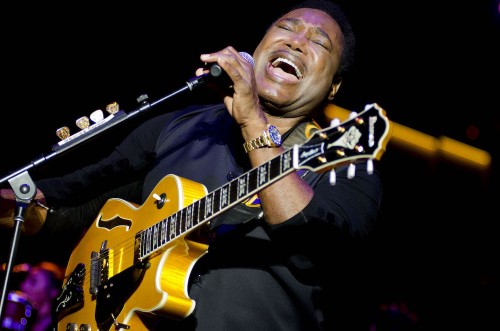Oct 28, 2025 10:47 AM
In Memoriam: Jack DeJohnette, 1942–2025
Jack DeJohnette, a bold and resourceful drummer and NEA Jazz Master who forged a unique vocabulary on the kit over his…

George Benson, shown here at the 2016 Detroit Jazz Festival, performs songs written by Fats Domino and Chuck Berry on his new album.
(Photo: C. Andrew Hovan)For his new album, George Benson turned to the past. On Walking To New Orleans (Provogue), the jazz guitarist/singer pays tribute to two rock ’n’ roll icons: Fats Domino and Chuck Berry, both of whom died in 2017. Featuring Domino classics like 1956’s “Blue Monday” and Berry’s 1959 hit “Memphis, Tennessee,” Benson’s 45th outing as a leader might be his first unabashedly rocking album. It also represents his coming full circle—back to his rock ’n’ roll roots as a precociously gifted kid growing up in Pittsburgh.
“I had a band called George Benson & His All-Stars, and we played rock ’n’ roll,” he recalled over the phone from his home in the Phoenix area. “We played whatever was on the jukebox, and both of those guys were on the jukebox all the time. So, making this record was relatively easy, because I remembered so many of those tunes. But I also knew better than to try and copy those icons. There’s only one Chuck Berry and only one Fats Domino. Both guys had their own distinctive character, their own vibe, their own sound.”
Recorded at Ocean Way Studios in Nashville with a group of first-call session players, Walking doesn’t have the typical elements Benson fans might expect, such as long segments of fiery fretwork with precisely picked 32nd notes. “We tried to keep it simple,” he explained. “It’s like each song is telling me what I should be playing. My job was to sing the song and not get in the way, because this whole project was about storytelling. All I can do is try to create a mat for those stories to rest on, and that requires a simpler approach to playing.”
Benson does, however, get in some of his signature solo licks on two tracks—Berry’s 1964 single “Nadine (Is It You?)” and Domino’s hit “Ain’t That A Shame,” which topped the r&b charts in 1955. “The bassist on the session, [Alison Prestwood], told me, ‘I was waiting for you to do that. Now, I hear George Benson!’ But I was trying to stay away from that because we didn’t want to get the attention away from what we were trying to accomplish, which was to bring back the beauty of the ’50s ... . And I didn’t want the audience to lose that vibe. They’ve heard me play; they know what I can do. But to stay somewhere in the ballpark of the originals would be a major coup.”
On his previous recording, 2013’s Inspiration: A Tribute To Nat King Cole, Benson saluted an artist who began his career as a jazz pianist before earning widespread popularity as a vocalist. Cole was an obvious role model for Benson, who gained notoriety as a hotshot young sideman in “Brother” Jack McDuff’s organ group before debuting as a leader, at age 21 on Prestige, with 1964’s strictly instrumental The New Boss Guitar Of George Benson. Columbia producer John Hammond then signed Benson to a deal with the label under the condition that he sing at least two songs per album. “It was part of my deal,” Benson recalled. “CBS Records told John Hammond, ‘We don’t need another guitar player.’ So when he told them I also sing, they said, ‘If he’s a singer, we’ll sign him.’ That’s how that came about.”
On the heels of his Columbia signing, the guitar great delivered soulful vocal renditions of “Summertime” and “A Foggy Day” on 1966’s It’s Uptown and “All Of Me” on 1967’s The George Benson Cookbook. His singing was prominently featured on his 1970 Beatles tribute, The Other Side Of Abbey Road (A&M), and on his 1976 smash, Breezin’ (Warner Bros.), which earned him three Grammy awards, including a Record of the Year honor for his rendition of Leon Russell’s “This Masquerade.”
And Benson still is in particularly good voice on Walking. “We did the whole session with just the band live in the studio, and the atmosphere was genuine,” he said. “When you hear them play, it’s part of their lifestyle, it’s who they are. They made me feel so comfortable, man, like this is what we should be doing. So, I’m going to have a lot of fun with this record when I go on tour.” DB

Jack DeJohnette boasted a musical resume that was as long as it was fearsome.
Oct 28, 2025 10:47 AM
Jack DeJohnette, a bold and resourceful drummer and NEA Jazz Master who forged a unique vocabulary on the kit over his…

D’Angelo achieved commercial and critical success experimenting with a fusion of jazz, funk, soul, R&B and hip-hop.
Oct 14, 2025 1:47 PM
D’Angelo, a Grammy-winning R&B and neo-soul singer, guitarist and pianist who exerted a profound influence on 21st…

Kandace Springs channeled Shirley Horn’s deliberate phrasing and sublime self-accompaniment during her set at this year’s Pittsburgh International Jazz Festival.
Sep 30, 2025 12:28 PM
Janis Burley, the Pittsburgh International Jazz Festival’s founder and artistic director, did not, as might be…

Jim McNeely’s singular body of work had a profound and lasting influence on many of today’s top jazz composers in the U.S. and in Europe.
Oct 7, 2025 3:40 PM
Pianist Jim McNeely, one of the most distinguished large ensemble jazz composers of his generation, died Sept. 26 at…

Drummond was cherished by generations of mainstream jazz listeners and bandleaders for his authoritative tonal presence, a defining quality of his style most apparent when he played his instrument unamplified.
Nov 4, 2025 11:39 AM
Ray Drummond, a first-call bassist who appeared on hundreds of albums as a sideman for some of the top names in jazz…